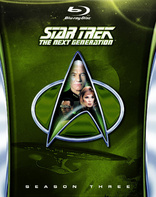Star Trek: The Next Generation, Season 3 Blu-ray Movie
HomeStar Trek: The Next Generation, Season 3 Blu-ray Movie 
Paramount Pictures | 1989-1990 | 1181 min | Rated TV-PG | Apr 30, 2013Movie rating
8.6 | / 10 |
Blu-ray rating
| Users | 4.5 | |
| Reviewer | 4.5 | |
| Overall | 4.5 |
Overview
Star Trek: The Next Generation, Season 3 (1989-1990)
Space... The final frontier... These are the voyages of the Starship Enterprise. Its continuing mission: To explore strange new worlds... To seek out new life and new civilisations... To boldly go where no one has gone before!
Starring: Patrick Stewart, Jonathan Frakes, Brent Spiner, Michael Dorn, Gates McFaddenDirector: Cliff Bole, Les Landau, Winrich Kolbe, Rob Bowman (I), Robert Scheerer
| Sci-Fi | Uncertain |
| Adventure | Uncertain |
| Action | Uncertain |
Specifications
Video
Video codec: MPEG-4 AVC
Video resolution: 1080p
Aspect ratio: 1.33:1
Original aspect ratio: 1.33:1
Audio
English: DTS-HD Master Audio 7.1 (48kHz, 24-bit)
English: Dolby Digital 2.0 (192 kbps)
German: Dolby Digital 2.0
Spanish: Dolby Digital 2.0
French: Dolby Digital 2.0
Italian: Dolby Digital 2.0
Japanese: Dolby Digital 2.0
Subtitles
English, French, German, Italian, Japanese, Spanish, Danish, Dutch, Finnish, Norwegian, Swedish
Discs
50GB Blu-ray Disc
Six-disc set (6 BDs)
Packaging
Slipcover in original pressing
Playback
Region A, B (C untested)
Review
Rating summary
| Movie | 5.0 | |
| Video | 4.5 | |
| Audio | 4.5 | |
| Extras | 5.0 | |
| Overall | 4.5 |
Star Trek: The Next Generation, Season 3 Blu-ray Movie Review
"Trek" has never been better.
Reviewed by Martin Liebman April 27, 2013Let's make sure history never forgets the name 'Enterprise.'
New uniforms, new writers, the return of an old friend, a guest appearance by another, and some of the finest hours of television ever to air --
under
the
Star Trek banner or not -- all shape season three of The Next Generation into, arguably, the best of the almost countless hours of
Star Trek Voyages through the years, in all
its numerous variants and on both the big and, primarily, small screens. Season three sees the maturation of The Next Generation, the
absolute fulfillment of its promise that was certainly hinted at -- and usually more -- in seasons one and two but brought to unmistakable completion here. The deep cast chemistry;
the
total realization of the potential for the dynamic character roster; and the perfect blend of fascinating exploration, intense action, intimate
character
study, and the many threads that weave
together the heart and soul of Science Fiction -- the deeply personal inward look at humanity through the forward-thinking outward prism of a
possible
future and even through the eyes of alien races -- all give shape to what is arguably the most impressive season Star Trek has ever known
across what is now five unique crews and, counting the animated adventures of Kirk and company, twenty-nine years of boldly going through the
final frontier on the small screen, now completely remastered and replicated for the high definition era.
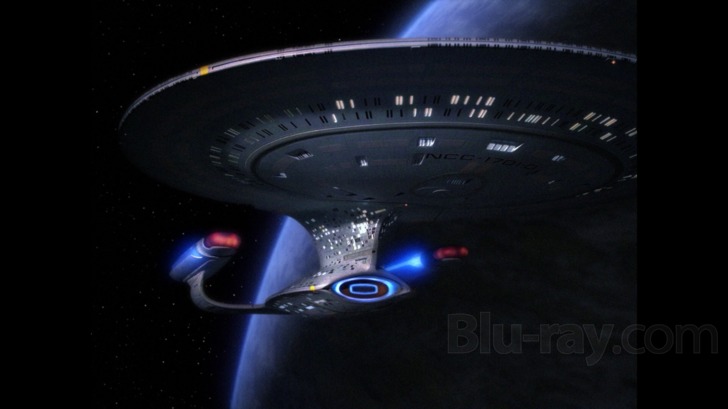
The beauty shot never gets old...especially in high definition.
Season three overflows with quality episodes, including several classics -- "Yesterday's Enterprise," "The Offspring," and "Best of Both Worlds, Part 1" -- that have largely come to define The Next Generation, reaching down into the series' emotional core, its grand sense of adventure, its slick action, its absorbing plot lines, and the largely faultless character roster and cast. The season is aided a great deal by the departure of the stiff Dr. Polaski and the return of the more fluid and approachable Beverly Crusher, a doctor who may lack the personality of McCoy, the intrigue of Bashir, the novelty and fantastic development of the holographic doctor, and the charm of Phlox but who adds a counter dynamic to Picard and a unique combination of outward gentleness and inward toughness that even Troi cannot bring to the series. Otherwise, the main cast remains the same -- as it will for the duration until the introduction of the quasi-regular Ensign Ro -- though some characters fail to find the exact same level of nuanced development and broader inclusion as main cogs in the majority of the stories, LaForge in particular and even as he settles into his role as ship's engineer. Season three runs with the idea of developing the bridge crew into something of a family unit while at the same time fulfilling the greater promise of the broader Trek universe that's more thoroughly explored in the season and the series. By the end of season three, the Next Generation crew breaks free from the shadow of the original series and charts its own path due largely to that unique Roddenberry ability to put together a character roster that's diverse yet capable of coming together in a future where such closeness is expected but also in a present time that offers hope for a better tomorrow. None of the subsequent three series found quite the same level of dynamic cast togetherness as The Next Generation - - Deep Space Nine came close, and that's with two TNG regulars in leading roles -- and it's that very real sense of family that makes The Next Generation the pinnacle of Star Trek.
Season three works through classic Science Fiction and Star Trek themes with a balance, flair, ingenuity, and purpose quite unlike any other show and precious few seasons. It's more than just action, instead sharing largely thoughtful tales that explore humanity, inhumanity, and everything in between in episodes like "The Ensigns of Command," "The Offspring," "Hollow Pursuits," "Sarek," and "The Best of Both Worlds." These, and other, episodes work through moral dilemmas and personal crises, yielding deep and absorbing emotional content that explores not only life in the future but life in the here-and-now through the prism of future events, interactions, and technologies. Even the most action-oriented episodes, like "Yesterday's Enterprise" that feel wonderfully cinematic and bigger than the medium, explore the role of faith and gut feelings not as separate entities but rather elements that can work in tandem for the purpose of noble pursuits, taking a chance through sacrifice of people and, really, an entire knowledge of life for the mere possibility of the greater good. The season explores human interaction, understanding, friendship, purpose, and the place of fantasy and escapism both in and from the real world in the wonderful "Hollow Pursuits." It examines death and how different people, cultures, even species deal with it in "The Bonding." It explores humanity through the absence thereof in the emotionally powerful "The Offspring." It delves deeply into loss, doubt, fear, purpose, and principle in "The Best of Both Worlds, Part 1." Season three is a true powerhouse of television, a season that reaches further than most any other in terms of bringing so many qualities into the fold. It develops its characters, expands its universe, and captures the attention, imagination, and allegiance of its audience like few shows -- let alone individual seasons -- before or after it. This is perfect television, and even with a few less-than-stellar episodes included, it's the pinnacle of Star Trek and episodic entertainment.
Season three highlight episodes include:
- The Ensigns of Command: A Ten-Forward concert is interrupted when Picard is called to the bridge. The Enterprise has been thrust into a dangerous situation with a mysterious alien race known as the Sheliak, a race with whom the Federation has a lengthy, detailed treaty. The Sheliak, a species with no regard for human life, are about to colonize an inhospitable-to-humans world under treaty guidelines, but a human colony has defied the odds -- and the planet's deadly hyperonic radiation -- and established a colony there, heretofore unbeknownst to either the Federation or the Sheliak. Data, immune to the effects of the radiation, is sent to the planet to inform the colonists of the situation and organize their evacuation. He finds a stubborn people, led by a man named Gosheven, that refuses to abandon all they, and their forefathers, have built. While Data -- with the help of a sympathetic colonist named Ard'rian -- works to find a way to convince colonists of the need to evacuate, Picard and the Enterprise crew frantically search for a way to remove the colonists in time -- transporters are useless because of the radiation, and shuttlecraft are too slow -- or discover an out clause in the treaty to buy them that time without resorting to hostilities against a determined foe.
- The Survivors: The Enterprise responds to a distress call from Delta-Rana IV. They find a devastated planet with no life form readings but for two that appear to be living undisturbed in the midst of the chaotic destruction around them. Riker, Dr. Crusher, Worf, Data, and Geordi beam down to the world where they discover an elderly couple, Kevin and Rishon Uxbridge. When Data plays with a small music box in the Uxbridge home, Counselor Troi, still on the Enterprise, feels the music in her head. It deeply moves her, troubles her; she cannot get the melody out of her mind and a nuisance becomes an incapacitating illness. Soon, another vessel appears from hiding, five times the Enterprise's mass and much more heavily armed. After the Enterprise is run off by the more powerful vessel, Picard begins to piece together the puzzle of how it seems a single couple lives on a decimated world, protected by the very vessel that theory suggests destroyed the rest of the planet.
- The Bonding: While on a routine away mission, an Enterprise team is caught in the blast radius of an old booby trap from a long-forgotten war. Unfortunately, the ship's archaeologist, Marla Aster, is killed when the explosive detonates. She is survived by a twelve-year-old son, Jeremy. His father is also deceased, and his only surviving relatives are an aunt and uncle back on Earth. Death is "a part of life in Starfleet," Riker says, but it becomes obvious very quickly that death isn't simply another process of life for the living. While Captain Picard and Counselor Troi attempt to console Jeremy, Worf comes to believe it is his duty -- his right -- to perform a Klingon bonding ceremony, known as R'usstai, with young Jeremy, but a surprise visitor threatens to tear apart Jeremy's fragile life for good.
- The Enemy: Riker, Geordi, and Worf beam down to the environmentally hostile world known as Galorndon Core, a planet within the Federation boundaries. There, they discover wreckage with Romulan markings. Worf makes another discovery: a surviving Romulan. Meanwhile, Geordi falls through a hole and becomes separated from the team. Worf, Riker, and the Romulan survivor beam back aboard the Enterprise. Conditions don't permit a rescue party, leaving Geordi stranded, at least temporarily, on the planet. While the Enterprise crew attempts to figure out why the Romulans were on the world and how to rescue its stranded colleague, Geordi is left below to survive with the help of an unlikely companion. At the same time, Worf is forced to face a personal moral crisis head-on.
- The Defector: Data and Picard's Holodeck lesson in Shakespearean acting is interrupted when the bridge calls with news of sensors detecting a Romulan scout ship inside the Neutral Zone. The Romulan on-board requires assistance; he's seeking asylum and is fleeing from several pursuing hostile warbirds. When he's beamed aboard and the immediate crisis is averted, the defector warns Picard of a pending Romulan invasion of Federation territory. A forward base of operations has been established -- without the Federation catching so much as a whiff of its construction -- and it will be fully operational in only two days time. War appears imminent, if he's telling the truth, that is. He sets his vessel to self-destruct, he possesses intimate knowledge of operations beyond the scope of his supposed ranking in the Romulan hierarchy, and the entire set-up seems all too convenient to draw the Enterprise illegally into the Neutral Zone. Picard and crew must discern the truth before engaging in any activity that could lead to war.
- Déjà Q: A moon is collapsing around the planet Bre'el IV. It's only a matter of hours before it mercilessly impacts the world below, an impact which will destroy countless lives and potentially engender a new ice age. The Enterprise engages in a futile effort to push the moon back into its original orbit. Suddenly, Q appears on the bridge, naked, stripped of his powers and forced out of the Continuum. He registers as fully human, wants to be treated as a human, and is locked in the ship's brig. Suddenly, a mysterious alien race known as the Calamarain attack Q in Ten-Froward, leaving the Enterprise to deal with the crisis on Bre'el IV, an old enemy who may be up to new tricks, and a new external threat at a most inopportune time.
- A Matter of Perspective: Commander Riker is beamed aboard the Enterprise just in time before the Federation space station he was just on suddenly explodes. A power drain was evident just before transport. The debris field suggests a reactor core problem. A local security force liaison arrives, forcing Picard's hand to seek the full story from an obviously troubled Riker. The security official immediately arranges Riker's arrest for his role in what is being deemed a murder. Witnesses claim Riker "threatened" the lone sole left on board the station when it was destroyed. Local law dictates a suspect guilty before being proven innocent, leaving Riker with no choice but to prove his innocence beyond the shadow of a doubt. Picard orders Data to analyze testimony and recreate the possible avenues of action that took place on the station leading up to the explosion in the Enterprise's holodeck.
- Yesterday's Enterprise: A "time displacement" appears directly ahead of the Enterprise and from it a vessel emerges, the Enterprise C. When it does, everything on the Enterprise D changes. She's suddenly in a wartime posture, a central player in a decades-long struggle with the Klingon Empire. What's more, the long-deceased Tasha Yar is manning the tactical position. The Enterprise C was thought destroyed two decades prior. Data theorizes she's been adrift in time. Scans reveal heavy damage but signs of life. An away team finds well over 100 survivors, including the captain and helmsman. While the rest of the crew believes everything to be as it should, Guinan feels something amiss and comes to believe that sending the Enterprise C back through the rift and to her doom could mean a return to the normal timeline in which the war never occurred and billions never died.
- The Offspring: With Riker away on personal leave, the Enterprise travels to sector 396 to chart an asteroid belt. En route, Data summons Wesley, Geordi, and Counselor Troi to his "secret labratory" to meet a humanoid android of his creation that he has named Lal. Lal is introduced as Data's "child" and is his own construction, built through the lessons he learned while in attendance at a cybernetics conference. He has crafted his child to be featureless, without gender and without species -- beyond humanoid -- so Lal may chose its own future. Captain Picard is shocked, concerned that Data does not understand the consequences of bringing a new life into the universe, even if it's not at all biological but rather completely technological. Now, Data must learn to be a parent who lacks even basic emotions, while Lal must determine how best to exist on board a starship with peers that do not understand its awkward ways while demonstrating some evolutionary skills even Data has yet to experience.
- Sins of the Father: For more information on this previously released-to-Blu-ray episode, please click here.
- Allegiance: The Enterprise is en route to USS Hood with orders to assist her in a terraforming mission. While relaxing in his quarters, Picard is transported off the ship and placed in a small, enclosed room with two additional guests and an obvious space for a yet-unarrived fourth captive. In the mystery room, Picard meets two aliens, one of whom is a Starfleet cadet, both of whom have been captive for days prior to Picard's arrival. They are fed with gelatinous discs and given no way out of the room save for a door panel that pains those who enter the incorrect code, a code too complex to guess at random. When the fourth abductee arrives, the prisoners must work together to escape or tear one another apart in the name of fear. Meanwhile, back on the ship, Worf and his security team follow up on a computer alert by conducting a welfare check on Picard; they find him relaxing in his quarters. "Picard" orders a communication blackout and issues strange orders which his loyal crew of course follows to the letter, but word and firsthand accounts of his odd behavior begin to circulate around the ship, leading the bridge crew to further clandestinely investigate its beloved captain.
- Hollow Pursuits: Lieutenant Barclay is having his way with his superior officers, pushing Geordi around, overpowering Riker, gaining the attention of a sexually aroused Counselor Troi. But it's all a holodeck simulation. In the 'deck, Barclay is confident, arrogant, even, but in real life he's a quiet, unconfident, aloof sort who is always late for duty and does only enough to scrape by at work in engineering. He's disliked by his peers and superiors alike, and he's earned the nickname "Broccoli" amongst his shipmates. Riker and Geordi want to see him gone, but Picard will not hear of it. He orders his officers to try harder to reach him rather than brush him off and make him someone else's problem. When Geordi follows orders, and Gunian's advice, to get to know Barclay better, he stumbles into his elaborate holodeck program that could land the awkward Lieutenant in very hot water. Meanwhile, it's discovered that two minor technical problems may be related and indicative of a larger, ship-wide issue.
- Sarek: The Enterprise is welcoming aboard the elderly Federation ambassador Sarek, a Vulcan who will be negotiating a critical treaty with a race known as the Legarans. He arrives with his wife, Perrin, and goes against the wishes of his staff, choosing to visit the ship's conference room rather than retire immediately to his quarters. Upon the ambassador's arrival, tensions rise and reports of erratic behavior begin to surface around the ship. Sarek himself shows heightened emotion while on board the Enterprise. It is feared he may be suffering from Bendii Syndrome, an illness that weakens a Vulcan's mental discipline, pushing emotions to the forefront of one's being. Additionally, it breaks down the emotional boundaries of those around the victim, leading to just the sort of raucous activity plaguing the Enterprise crew. Now, Picard must aid Sarek by undergoing a dangerous bonding with the alien ambassador.
- The Best of Both Worlds, Part 1: For more information on this previously released-to-Blu-ray episode, please click here.
Star Trek: The Next Generation, Season 3 Blu-ray Movie, Video Quality 
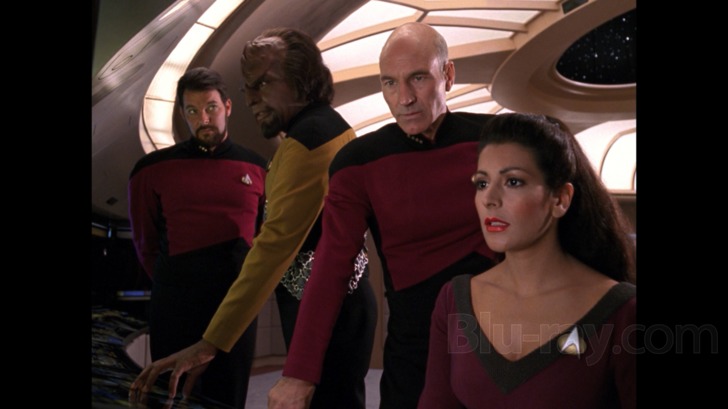
Clearly, there hasn't been much difference between the previous Next Generation releases in terms of picture quality -- the results have been uniformly outstanding -- but Star Trek: The Next Generation, Season 3 might show an ever-so-slight edge ahead of seasons one and two. This one looks positively splendid. There's nary a speckle to be seen, hardly a shot that isn't Star Trek picture-perfect. To be sure, there are a handful of softer shots throughout the course of the season -- a few shots of Doctor Crusher sandwiched around sharper footage at the beginning of "The Ensigns of Command," for example -- but the overwhelming majority of the season makes for an absolutely remarkable viewing experience that's sure to dazzle even the most demanding viewer and transfix longtime Star Trek fans who will feel like they're watching these episodes all over again for the very first time. Details are amazing, to put it simply. Of course, all of the usual elements stand out -- lines in uniforms, creases in the bridge's leather seats, the wood trim wrapping around tactical, the sharpness of the LCARS displays, Data's and Worf's makeup -- but what really looks fantastic this season is the attention to detail seen on Enterprise beauty shots as she orbits planets or appears otherwise stationary or slow-moving from space. The model reveals with impeccable clarity words and windows on the hull to gorgeous film-like effect. It's amazing just how awesome such shots look, a real testament both to the revamped visuals and the power of the film-quality, largely flawless transfer on display. Colors are wonderful, too; there's a startling balance across the three primary shades of Starfleet uniforms, not to mention the pleasing lighter hues seen throughout the ship, from beige accents to light purple carpeting. The green surface down on Delta-Rana as seen in the episode "The Survivors" offers a striking display of natural beauty that couldn't be more picture-perfect. Skin textures are amazing, whether light colors, darker tones, or makeup-influenced hues from a number of alien races. Black levels, too, are perfectly deep and pure. It never gets old, re-watching these episodes on Blu-ray, and there's hardly ever a shot that's anything less than a fan's wildest dream come true.
Star Trek: The Next Generation, Season 3 Blu-ray Movie, Audio Quality 
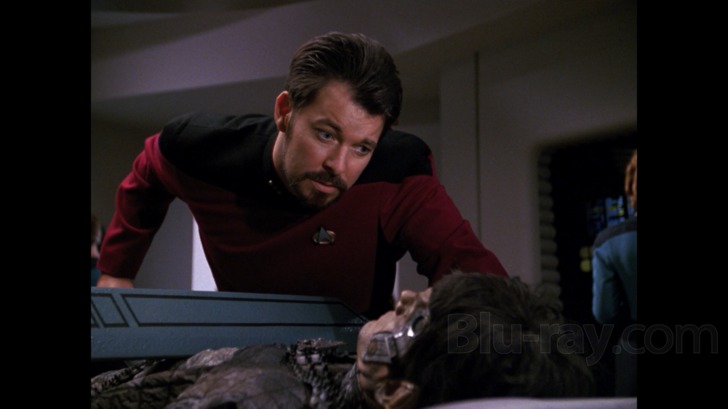
Star Trek: The Next Generation, Season 3 features the series-standard DTS-HD Master Audio 7.1 lossless soundtrack, and like the rest, it's spectacular. A perusal of the previous Next Generation release reviews -- either of the full seasons or one or both of the smaller single-disc offerings -- would offer basically the same insight as this review, and that consistency is a wonderful thing. The top end of music can come across as a little sharp and harsh, particularly over the opening titles that play at a rather high, aggressive volume at reference levels. However, the swooping Enterprise is a thing to behold as it rushes from one speaker to the next in several unique directions as the blue titles appear on the screen. General music throughout the episodes plays with precision spacing and an obvious, but not overpowering, surround sound element. Listeners will enjoy the near-constant humming of the engines on board the ship; the effect is so natural it blends right into the background, faultlessly enveloping the listener whether moderately on the bridge, lightly in Ten-Forward, or more heavily in engineering. Various episode-specfic sound effects are nicely implemented throughout the season. There are some big, heavy electrical sound elements to begin "The Enemy" and Romulan vessel phaser fire in "The Defector," both of which work the stage with a natural flair. Dialogue is fantastic, whether delivered through the quiet backdrop of Picard's ready room, a bit more loudly in Engineering, through the din of Ten-Forward, or in the heat of battle in "Yesterday's Enterprise." This is a great track, very well balanced but at the same time highly aggressive and clear. Fans know what to expect, and newcomers are in for a real treat.
Star Trek: The Next Generation, Season 3 Blu-ray Movie, Special Features and Extras 
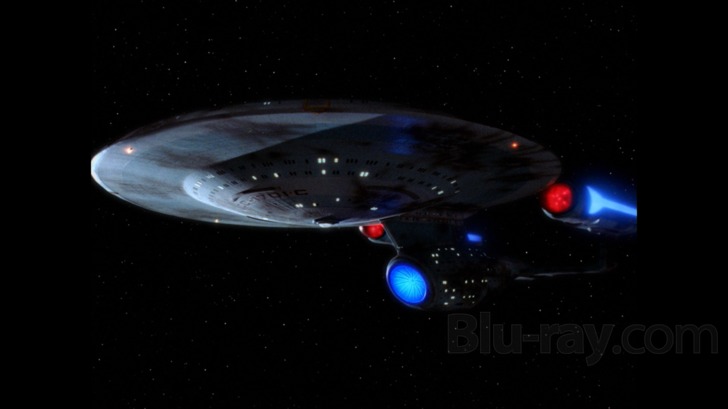
Star Trek: The Next Generation, Season 3 contains a treasure trove of fantastic supplements, both new and old. Discs one through five,
primarily, handle the vintage material, presented in standard definition, while disc six offers nearly three hours of new HD supplements. The
primary theme revolves around the writers, with a dedicated roundtable supplement as well as additional insights into the writers and the writing
process'
evolution in season three. Additionally, various audio commentaries are included with the season's best episodes. Note that extras for "The Best of
Both
Worlds, Part One" are only included on the standalone double-episoide release, while "Sins of the Father" earns supplements not found on
the previously released sampler disc.
Disc One:
- Audio Commentary: Writer Ronald D. Moore and Star Trek experts Mike & Denise Okuda chat about the episode "The Bonding."
- Mission Overview: Year Three (SD, 17:41): A look at the season's best episodes, including "Yesterday's Enterprise" and "The Offspring," the difficult early circumstances surrounding the season due to an absence of scripts and creativity, Beverley Crusher's return, Frakes' turn in the director's chair, Whoopi Goldberg's role in the season and the importance of Star Trek in her life, visitors to the set, and the season's final episode.
- Episodic Promos (SD): Corny TV advertisements for each episode.
Disc Two:
- Selected Crew Analysis Year Three (SD, 13:51): A closer look at Picard, the Crushers, the Riker-Troi relationship, Majel Barrett's role in the series, Worf, and both LaForge's promotion to Chief Engineer and his sexuality.
- Episodic Promos (SD).
Disc Three:
- Audio Commentaries: The all-time classic Star Trek episode "Yesterday's Enterprise" earns a pair of tracks. The first is with Writers Ronald D. Moore and Ira Steven Behr and Trek experts Mike & Denise Okuda. Track two features Director David Carson.
- Departmental Briefings Year Three: Memorable Missions (SD, 13:25): A piece that features cast and crew briefly discussing various elements from the episodes "Sarek," "The Offspring," "Deja Q," "The Most Toys," "Who Watches the Watchers?," "The Enemy," and "Ménage à Troi."
- Episodic Promos (SD).
Disc Four:
- Audio Commentaries: Writer Rene Echevarria and Trek experts Mike & Denise Okuda speak on "The Offspring." "Sins of the Father" also earns a track with Writer Ronald D. Moore, Visual Effects Supervisor Dan Curry, and Trek experts Mike & Denise Okuda.
- Departmental Briefing Year Three: Production (SD, 20:04): An overview look at the season's new writers, including Rene Echevarria; design and visual effects in the episodes "Yesterday's Enterprise," "Deja Q," "Captain's Holiday," "Sins of the Father," and "Tin Man;" ship models; music and sound effects; and the importance of technical consultants in the season.
- Episodic Promos (SD).
Disc Five:
- In Memoriam: David Rappaport (HD, 5:07): A collection of scenes featuring the actor performing in "The Most Toys." Rappaport ended his own life while in the process of filming the episode.
- Gag Reel (HD, 8:37).
- Episodic Promos (SD).
Disc Six:
- Star Trek: The Next Generation, Inside the Writer's Room (HD, 1:10:52): Seth MacFarlane hosts a roundtable discussion with many of the Next Generation writers, including Naren Shankar, Rene Echevarria, Ronald Moore, and Brannon Braga. Between some lighthearted banter, they discuss how they became part of the writing team, the details behind various episodes, best and worst writing moments, penning the finale up against the first feature film, humorous moments from the set, the light humor in the series, hypothetical season eight story lines, and more. This is a superb supplement that's fun, enlightening, and packed with relevant and interesting information, much of which will be new to even dedicated Trek fans. It alone makes this supplemental package one of the best available to date.
- Resistance is Futile -- Assimilating Star Trek: The Next Generation (HD): A three-part Documentary that begins with Biological Distinctiveness (30:02), a piece that examines separating the show from the original series, the relationships and contributions of the creative team behind the show, bringing aboard new writers, and Michael Piller's "writers memo" that caused a rift in the writing room. Part two, Technological Distinctiveness (29:54), opens with a glimpse into the episode "The Ensigns of Command" and moves on to take a closer look at the writing process, the place of the holodeck in the show, the importance of "Sins of the Father" in allowing the show to build larger character arcs that extend beyond single episodes, writing "Yesterday's Enterprise," bringing back the character Sarek (Spock's father), ideas Roddenberry scrapped and wanted in the show, Michael Piller's contributions, and the importance of "The Best of Both Worlds" to the Star Trek universe. Finally, The Collective (30:04) focuses on the characters, including the return of Gates McFadden; the series' cinematography; each actor's challenges in the show; Jonathan Frakes' directorial debut; Denise Crosby's return in "Yesterday's Enterprise;" Riker's character arc; and more.
- A Tribute to Michael Piller (HD, 13:50): Cast and crew remember the late Screenwriter and Producer.
- Episodic Promos (SD).
Star Trek: The Next Generation, Season 3 Blu-ray Movie, Overall Score and Recommendation 
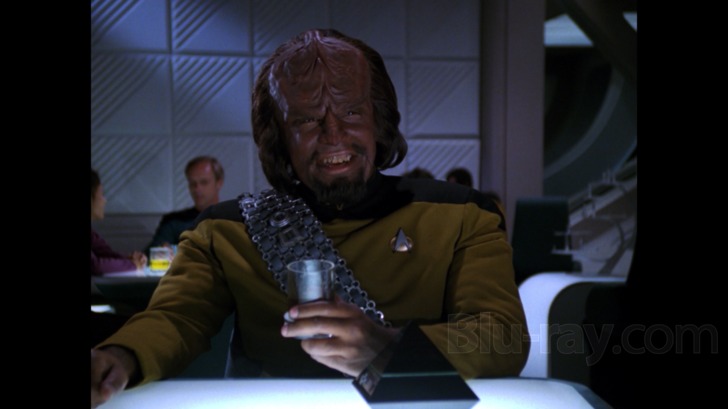
Simply put, Star Trek: The Next Generation, Season 3 represents the very best of Star Trek. It doesn't contain all the best episodes, but what's here are amongst the very finest the series and the entire Trek universe has ever seen. It all comes together -- cast, characters, stories, plot arcs, emotions, -- opening an entire galaxy's worth of content with a broad range of actions and feelings that blend together like only Star Trek can deliver. Season three's Blu-ray technical presentations are largely above reproach, and the wonderful supplemental content -- spread across all six discs -- is almost alone worth the price of assimilation. This is one of the finest releases of 2012 and earns my highest recommendation.
Other editions
Star Trek: The Next Generation: Other Seasons

Star Trek: The Next Generation, The Next Level
A Taste of TNG in High Definition
1987-1992

Star Trek: The Next Generation, Season 1
Corrected version red Starfleet symbol on spine/yellow UPC
1987-1988

Star Trek: The Next Generation, Season One
1987-1988

Star Trek: The Next Generation, Season 2
1988-1989

Star Trek: The Next Generation, Season 3
1989-1990

Star Trek: The Next Generation - The Best of Both Worlds
1990

Star Trek: The Next Generation, Season 4
1990-1991

Star Trek: The Next Generation - Redemption
1991

Star Trek: The Next Generation, Season 5
1991-1992

Star Trek: The Next Generation - Unification
1991

Star Trek: The Next Generation - Unification
1991

Star Trek: The Next Generation, Season 6
1992-1993

Star Trek: The Next Generation - Chain of Command
1992

Star Trek: The Next Generation, Season 7
1993-1994

Star Trek: The Next Generation - All Good Things
1994
Similar titles
Similar titles you might also like

Star Trek: Enterprise: The Complete Series
Budget Re-release
2001-2005

Star Trek: The Complete Original Series
1966-1969

Star Trek: Voyager
1995-2001

Star Trek: Generations 4K
1994

Star Trek: First Contact 4K
1996

Star Trek: Insurrection 4K
1998

Star Trek: Nemesis 4K
2002

Star Trek: Picard - The Complete Series
2020-2023

Star Trek V: The Final Frontier 4K
1989

Star Trek II: The Wrath of Khan 4K
1982

Star Trek III: The Search for Spock 4K
1984

Star Trek IV: The Voyage Home 4K
1986

Star Trek VI: The Undiscovered Country 4K
1991

Star Trek: Deep Space Nine
1993-1999

Battlestar Galactica: The Complete Series
2003-2009

Star Trek: The Motion Picture 4K
The Director's Edition | Remastered
1979

Stargate Universe: The Complete Series
2009-2011

Battlestar Galactica
The Remastered Collection
1978-1980

Stargate Atlantis: The Complete Series
2004-2009

Lost in Space 4K
Limited Edition
1998
